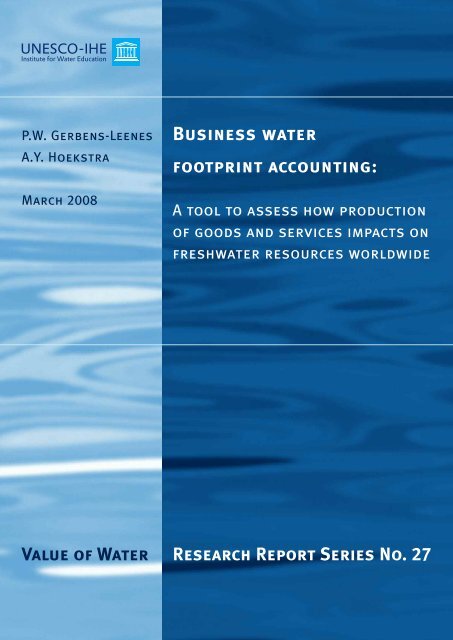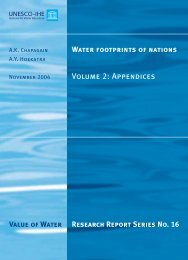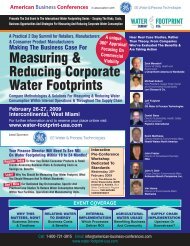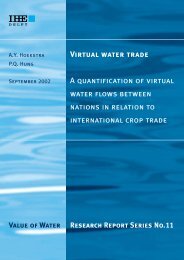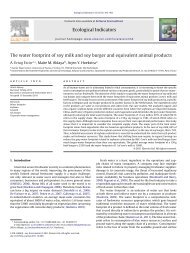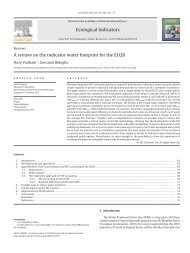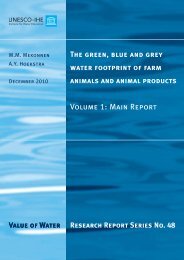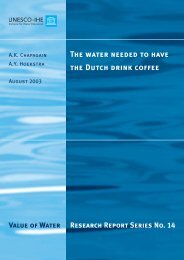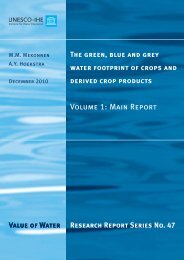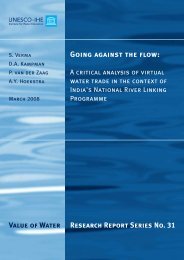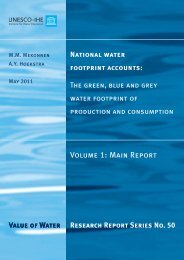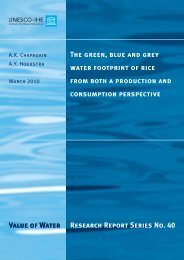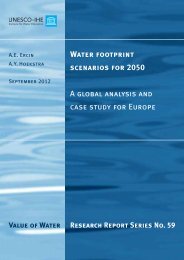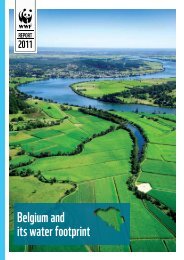Business water footprint accounting: A tool to assess how production
Business water footprint accounting: A tool to assess how production
Business water footprint accounting: A tool to assess how production
- No tags were found...
You also want an ePaper? Increase the reach of your titles
YUMPU automatically turns print PDFs into web optimized ePapers that Google loves.
Electrical Installation Remove the instrument enclosure lid by unscrewing in a counterclockwise direction. Loosen the two, board-retaining captured screws. Remove the printed circuit board by grasping the transformer on the center of theboard and, while rocking gently back and forth, pull firmly outward. Connect power and alarm relay wiring <strong>to</strong> Terminal Block TBB as s<strong>how</strong>n in . Reinstall the switch electronics and tighten the retention screws.NOTE: Connections <strong>to</strong> sensors are fac<strong>to</strong>ry installed and should not be disconnected in the fi eld.NOTE: For 24 VDC operation (fac<strong>to</strong>ry prepared), connect +24 VDC <strong>to</strong> TBB7 and 24 VDC return <strong>to</strong>TBB8. For 115 VAC or 230 VAC operation, there is no polarity.NOTE: Connect ground wire <strong>to</strong> the ground screw located in back of instrument enclosure. Aground wire must be attached <strong>to</strong> the ground screw located inside and on the back ofinstrument head for proper operation.4/12 Form 1024 (08.13) ©SOR Inc.
ContentsSummary................................................................................................................................................................ 51. General introduction......................................................................................................................................... 71.1 Introduction................................................................................................................................................... 71.2 Aim and research questions........................................................................................................................... 72. Current state of business <strong>water</strong> <strong>accounting</strong>.................................................................................................... 92.1 Sustainable business performance................................................................................................................. 92.2 Principles, practices and outcomes................................................................................................................ 92.3 Initiatives for business <strong>water</strong> <strong>accounting</strong> .................................................................................................... 102.3.1 OECD’s key environmental indica<strong>to</strong>rs................................................................................................. 102.3.2 The Sustainable Corporate Performance Project.................................................................................. 102.3.3 WBCSD’s Global Water Tool.............................................................................................................. 112.3.4 The CEO Water Mandate..................................................................................................................... 113. Methods............................................................................................................................................................ 133.1 A broad definition of business .................................................................................................................... 133.2 <strong>Business</strong> sec<strong>to</strong>rs, companies and company units ........................................................................................ 133.3 The business <strong>water</strong> <strong>footprint</strong> ....................................................................................................................... 153.4 Calculation method for the business <strong>water</strong> <strong>footprint</strong>................................................................................... 16Step 1: definition of the business and business units .................................................................................... 16Step 2: the operational <strong>water</strong> <strong>footprint</strong> per business unit .............................................................................. 18Step 3: the supply-chain <strong>water</strong> <strong>footprint</strong> per business unit............................................................................ 18Step 4: the <strong>to</strong>tal <strong>water</strong> <strong>footprint</strong> per business unit ......................................................................................... 19Step 5: the <strong>water</strong> <strong>footprint</strong> of the output products per business unit ............................................................. 19Step 6: the <strong>water</strong> <strong>footprint</strong> of the <strong>to</strong>tal business ............................................................................................ 203.5 From <strong>footprint</strong> <strong>accounting</strong> <strong>to</strong> impact <strong>assess</strong>ment and from impacts <strong>to</strong> policy ............................................ 204. Application of the method for a theoretical beverage company.................................................................. 214.1 Case I: the business as a black box.............................................................................................................. 224.2 Case II: the business schematised in<strong>to</strong> business units ................................................................................. 234.3 A comparison between the two cases.......................................................................................................... 255. Discussion......................................................................................................................................................... 276. Conclusion ....................................................................................................................................................... 29Acknowledgements.............................................................................................................................................. 31References............................................................................................................................................................ 33Appendix 1: Glossary.......................................................................................................................................... 37Appendix 2: Overview of largest companies per business sec<strong>to</strong>r with a relatively large <strong>water</strong> <strong>footprint</strong>... 39
SummaryFresh<strong>water</strong> of adequate quality is a prerequisite for human societies and natural ecosystems. The human use offresh<strong>water</strong> is so large that competition among users occurs and <strong>water</strong> scarcity is serious in several regions. Formany companies, fresh<strong>water</strong> is a basic ingredient for their operations, while effluents may lead <strong>to</strong> pollution ofthe local hydrological ecosystem. Initially, public pressure has been the most important reason for sustainablebusiness initiatives, but <strong>to</strong>day many companies recognize that failure <strong>to</strong> manage the fresh<strong>water</strong> issue raises risks,including damage <strong>to</strong> the corporate image, threat of increased regula<strong>to</strong>ry control, financial risks caused bypollution, or insufficient fresh<strong>water</strong> availability for operations. Especially multinationals, such as the Coca-ColaCompany or Marks & Spencer, recognise that proactive management contributes <strong>to</strong> their profitability andcompetitiveness in the market and avoids risks (Coca-Cola Company, 2006; Marks & Spencer, 2007). <strong>Business</strong><strong>water</strong> <strong>accounting</strong> is increasingly regarded as an essential part of sustainable corporate performance <strong>accounting</strong>.The foundation of the World <strong>Business</strong> Council on Sustainable Development (WBCSD) and the Global ReportingInitiative (GRI), and the development of standards for environmental management systems (ISO and EMAS)have been important. Since 2000, indica<strong>to</strong>rs for business <strong>water</strong> <strong>accounting</strong> have been proposed by the OECD, theUniversity of Groningen and the WBCSD. For fresh<strong>water</strong>, Hoekstra and Hung (2002) and Hoekstra andChapagain (2008) have developed the concept of the <strong>water</strong> <strong>footprint</strong> (WF) that has been applied, among otherthings, for individual and national consumption comparisons.This report aims <strong>to</strong> identify the current state of business <strong>water</strong> <strong>accounting</strong> and <strong>to</strong> design an <strong>accounting</strong> methodfor the business <strong>water</strong> <strong>footprint</strong> (BWF). It answers the following questions: (i) What are the main developmentsin sustainable business performance so far? (ii) What is the current state of business <strong>water</strong> <strong>accounting</strong>? (iii) How<strong>to</strong> design an <strong>accounting</strong> method for the business <strong>water</strong> <strong>footprint</strong>? And (iv) How <strong>to</strong> apply the method for existingsituations? The term “business” is interpreted in this study in a broad sense, in order <strong>to</strong> include any form ofenterprise, governmental or non-governmental organization or other form of business activity. Based on themethodology of the WF concept, this report designs an <strong>accounting</strong> method for the BWF. The method calculatesthe BWF per business unit, where a business unit is preferably a part of the business that produces onehomogenous product (good or service) at one particular spot. The WF of a business unit is defined as the <strong>to</strong>talvolume of fresh<strong>water</strong> that is used, directly and indirectly, <strong>to</strong> produce the goods and services delivered by thatunit expressed in terms of the volume of fresh<strong>water</strong> use per year. The WF of a business is defined as the <strong>to</strong>talvolume of fresh<strong>water</strong> that is used directly or indirectly <strong>to</strong> run and support the business.The WF of a business unit consists of two parts: the operational <strong>water</strong> <strong>footprint</strong> and the supply-chain <strong>water</strong><strong>footprint</strong>. The operational <strong>water</strong> <strong>footprint</strong> is the amount of fresh<strong>water</strong> used at a specific business unit, i.e. thedirect fresh<strong>water</strong> use. The supply-chain <strong>water</strong> <strong>footprint</strong> is the amount of fresh<strong>water</strong> used <strong>to</strong> produce all the goodsand services that form the input of <strong>production</strong> at the specific business unit, i.e. the indirect fresh<strong>water</strong> use. Themethod addresses three different types of fresh<strong>water</strong> use: blue, green and grey. The blue <strong>water</strong> <strong>footprint</strong> is thevolume of fresh<strong>water</strong> that evaporated from the global blue <strong>water</strong> resources (surface <strong>water</strong> and ground <strong>water</strong>) <strong>to</strong>produce the goods and services. The green <strong>water</strong> <strong>footprint</strong> is the volume of <strong>water</strong> evaporated from the globalgreen <strong>water</strong> resources (rain<strong>water</strong> s<strong>to</strong>red in the soil as soil moisture). The grey <strong>water</strong> <strong>footprint</strong> is the volume of
8 / <strong>Business</strong> <strong>water</strong> <strong>footprint</strong> <strong>accounting</strong>1. Compared <strong>to</strong> other <strong>water</strong> <strong>accounting</strong> <strong><strong>to</strong>ol</strong>s, the concept of the <strong>water</strong> <strong>footprint</strong> provides the most extended andcomplete <strong><strong>to</strong>ol</strong> for <strong>water</strong> <strong>accounting</strong>. It has already been applied for various purposes, such as the calculation ofthe <strong>water</strong> <strong>footprint</strong> of a large number of products from all over the world (Chapagain and Hoekstra, 2004), but sofar there has been no application for business <strong>accounting</strong>. This report aims <strong>to</strong> identify the current state ofbusiness <strong>water</strong> <strong>accounting</strong> and <strong>to</strong> design an <strong>accounting</strong> method for the business <strong>water</strong> <strong>footprint</strong>. The researchquestions are:• What are the main developments in sustainable business performance so far?• What is the current state of business <strong>water</strong> <strong>accounting</strong>?• How <strong>to</strong> design an <strong>accounting</strong> method for the business <strong>water</strong> <strong>footprint</strong>?• How <strong>to</strong> apply the method for existing situations?The answer <strong>to</strong> the first question intends <strong>to</strong> provide general information on where business stands <strong>to</strong>day. Theanswer <strong>to</strong> the second question forms the starting-point for the development of the method. In this way, the reportcan play a role in raising awareness on the <strong>water</strong> scarcity issue, as well as provide insight in<strong>to</strong> options forchange. The answer <strong>to</strong> the third question provides a <strong><strong>to</strong>ol</strong> for <strong>accounting</strong> the business <strong>water</strong> <strong>footprint</strong> based on theconcept and methodology of the <strong>water</strong> <strong>footprint</strong>. The answer <strong>to</strong> the fourth question s<strong>how</strong>s <strong>how</strong> the method worksin practice.
2. Current state of business <strong>water</strong> <strong>accounting</strong>2.1 Sustainable business performanceThe way companies address their use of fresh<strong>water</strong> and their impact on <strong>water</strong> systems is one of the aspects ofsustainable business performance. During the past few decades we have seen a movement recognising thatbusiness performance is not only measured in terms of shareholder value but also in terms of the long-termcontinuity value of business <strong>to</strong> communities. In the ongoing debate on globalization, concerns have beenexpressed about the sustainability impacts of business on society, especially of multinational corporations(OECD, 2001). The sustainability concept is determined by three components: a social, economic, andenvironmental one (WCED, 1987). Public pressure has been the most important reason that private initiatives forsustainable business performance have become an important development in business over the last twenty years;especially a number of large multinationals are interested in the interactions of their operations with theenvironment and communities (Gerbens-Leenes et al., 2003). Initially, regula<strong>to</strong>ry compliance and fear of legalliability were the main reasons for defining sustainability principles; <strong>to</strong>day, many multinationals recognise thatproactive management contributes <strong>to</strong> their profitability and competitiveness in the market.Companies change performance in response <strong>to</strong> specific pressure (Hall, 2000). It has been s<strong>how</strong>n that thispressure differs among sec<strong>to</strong>rs (Green et al., 1996; Hall, 2000). In general, large, high-profile companies areunder considerable pressure <strong>to</strong> improve their performance. For example, multinational oil companies are moreenvironmentally responsive than other company types (Moser, 2001). In contrast, firms without pressure may behesitant <strong>to</strong> invest in innovation because it does not necessarily improve their financial performance. Therefore,lower profile firms, which are an integral part of any industrial system, lack incentives <strong>to</strong> change theirsustainability performance (Irwin and Hooper, 1992). These pressures need <strong>to</strong> be responded <strong>to</strong> on two levels,<strong>how</strong>ever, at an industry level and at a corporate level, since it is impossible for a company <strong>to</strong> develop a goodreputation for itself in an industry without credibility. What is more, companies must not only behave in aresponsible manner according <strong>to</strong> their principles, they must also be seen <strong>to</strong> do so (Humphreys, 2000). In thisrespect, differences among companies in the emphasis on the components of the sustainability concept makesthat the use of this concept leads <strong>to</strong> the use of different time scales, so that the perspective on sustainablebusiness performance differs according <strong>to</strong> varying perceptions about the appropriate time horizon in the analysis(Gerbens-Leenes et al., 2003).2.2 Principles, practices and outcomesThere are three important steps <strong>to</strong>wards the measurement and the reporting of sustainability (Gerbens-Leenes etal., 2003). The first step was in the 1970s. Companies started <strong>to</strong> issue policy statements or principles, codes ofconduct, stating commitments on business ethics and legal compliance (OECD, 2001). The first corporate codeof conduct was the 1977 “Issuance of guidelines on conducting business in South Africa” by an au<strong>to</strong>mobilemanufacturer. Later, many other companies adopted these “Sullivan Principles”, or began <strong>to</strong> issue corporatecodes dealing with business ethics. The second step was the development of management systems or practices
10 / <strong>Business</strong> <strong>water</strong> <strong>footprint</strong> <strong>accounting</strong>that refer <strong>to</strong> action strategies and programs. More recently, the third step formulated the outcomes, standardsproviding guidance for business reporting on non-financial performance. However, many companies mainlyfocus on their own performance, and only some firms feel responsible for their suppliers’ activities (Hall, 2000).Moreover, according <strong>to</strong> an OECD study (2001), the absence of internationally agreed reporting standards onsustainability results in a range from rudimentary reporting <strong>to</strong> full-scale reporting.2.3 Initiatives for business <strong>water</strong> <strong>accounting</strong><strong>Business</strong> <strong>water</strong> <strong>accounting</strong> is often part of the sustainable corporate performance <strong>accounting</strong> of a company.Important developments for the issue of sustainable, corporate performance were the foundation of the World<strong>Business</strong> Council for Sustainable Development (WBCSD, 1997), the foundation of the Global ReportingInitiative (GRI, 2000), and the development of standards for environmental management systems, such as theISO and EMAS standards (OECD, 2001). At the end of the 20 th century, many multinationals certified theirenvironmental management systems (EMS) under ISO 14000 standards, and many others were in the process ofdoing so (Rondinelli and Vastag, 2000). Today, an increasing number of companies publish information onenvironmental impacts of their activities, the outcomes. Although companies recognize the importance ofsustainability issues, they use an enormous variety of indica<strong>to</strong>rs for the <strong>assess</strong>ment (Gerbens-Leenes et al.,2003). Often, this also includes the use of fresh<strong>water</strong>. Moreover, sustainable business practices incline <strong>to</strong> focuson company performance rather than system performance. If companies mainly centre on impacts generated bytheir own activities, large company efforts may still result in small improvements along the <strong>to</strong>tal lifecycle of aproduct. Since 2000, initiatives for business <strong>water</strong> <strong>accounting</strong>, often part of a larger <strong>accounting</strong> scheme, havebeen taken. Three are discussed in the following: OECD’s key environmental indica<strong>to</strong>rs (OECD, 2001), theSustainable Corporate Performance project (Steg et al., 2001) and the Global Water Tool (WBCSD, 2007).2.3.1 OECD’s key environmental indica<strong>to</strong>rsIn 2001, the OECD Environmental Direc<strong>to</strong>rate (OECD, 2001) published a report on key environmentalindica<strong>to</strong>rs in an effort <strong>to</strong> reduce the number of environmental indica<strong>to</strong>rs and <strong>to</strong> draw attention <strong>to</strong> keyenvironmental issues of concern. One of the key environmental indica<strong>to</strong>rs was fresh<strong>water</strong>, divided in<strong>to</strong> twocategories: fresh<strong>water</strong> quality and fresh<strong>water</strong> resources. Indica<strong>to</strong>rs in this respect were waste<strong>water</strong> treatment andgross abstractions per capita as percentage of <strong>to</strong>tal available fresh<strong>water</strong> resources.2.3.2 The Sustainable Corporate Performance ProjectIn 2001, results of the Sustainable Corporate Performance (SCP) project, a cooperation between the Universityof Groningen in the Netherlands and the Ahold company, were published (Steg et al., 2001). Its focus was thedefinition of SCP and the development of a practical measuring system for companies. It defined SCP in relation<strong>to</strong> the potential addition of economic, social and environmental value <strong>to</strong> society through corporate activities.Gerbens-Leenes et al. (2003) designed and developed a measuring method for the environmental value usingthree indica<strong>to</strong>rs: land use, energy use and fresh<strong>water</strong> use. Fresh<strong>water</strong> use was made up of two parts: direct
<strong>Business</strong> <strong>water</strong> <strong>footprint</strong> <strong>accounting</strong> / 11fresh<strong>water</strong> use for a company per year (operational fresh<strong>water</strong> use) and indirect fresh<strong>water</strong> use, i.e. thefresh<strong>water</strong> use in the supply chain of the company.2.3.3 WBCSD’s Global Water ToolIn their recent <strong>water</strong>-scenarios report, the World <strong>Business</strong> Council for Sustainable Development (WBCSD)includes in one of their scenarios that ‘<strong>water</strong> <strong>footprint</strong> reporting’ will become common practice and evenobliga<strong>to</strong>ry for businesses in various countries already by the year 2010 (WBCSD, 2006). Shortly after, at theWorld Water Week 2007 in S<strong>to</strong>ckholm, the WBCSD launched the Global Water Tool, a free and easy-<strong>to</strong>-use<strong><strong>to</strong>ol</strong> for businesses and organizations <strong>to</strong> map their <strong>water</strong> use and <strong>assess</strong> risks relative <strong>to</strong> their global operationsand supply chains (WBCSD, 2007). Six important questions for business were: (i) How many of your sites are inextremely <strong>water</strong>-scarce areas? (ii) Which sites are at greatest risk? (iii) How will that look in the future? (iv)How many of your employees live in countries that lack access <strong>to</strong> improved <strong>water</strong> and sanitation? (v) How manyof your suppliers are in <strong>water</strong> scarce areas now? And (vi) How many will be in 2025? The Global Water Toolcalculates <strong>water</strong> withdrawal from fresh and non-fresh<strong>water</strong> sources (m 3 /year), fresh and non-fresh<strong>water</strong>discharge by receiving bodies (m 3 /year), and <strong>to</strong>tal <strong>water</strong> consumption of a company calculated as the sum ofwithdrawals minus discharges (WBCSD, 2007).2.3.4 The CEO Water MandateIn July 2007, at the Global Compact Leaders Summit in Geneva, a group of committed business leadersofficially launched The CEO Water Mandate, representing both a call <strong>to</strong> action and a strategic framework forcompanies seeking <strong>to</strong> address the issue of <strong>water</strong> sustainability not only in their operations but also in their supplychains (CEO Water Mandate, 2007). At the time of writing, the mandate was endorsed by twenty businessleaders and their companies.
3. Methods3.1 A broad definition of businessWe would like <strong>to</strong> develop a <strong>water</strong> <strong>footprint</strong> <strong>accounting</strong> method that can be applied <strong>to</strong> various sorts of business.The method should be applicable <strong>to</strong> small and large private companies but also <strong>to</strong> public organizations. Besides,we want a method that can be applied <strong>to</strong> both business at a disaggregated level (units or divisions within a largercorporation or organization) and business at an aggregated level (e.g. a whole business sec<strong>to</strong>r or the entirenational government). Before we introduce a method for business <strong>water</strong> <strong>footprint</strong> <strong>accounting</strong>, we will thereforefirst define what we understand by the term “business”.In broad terms, a business is conceived here as a coherent entity producing goods and/or services that aresupplied <strong>to</strong> consumers or other businesses. It can be a (division of a) private company or corporation, but also a(component of a) governmental or non-governmental organization. It can refer <strong>to</strong> various levels of scale, forinstance a specific division of a company, an entire company or a whole business sec<strong>to</strong>r. In our broad definitionthe term business can also refer <strong>to</strong> a consortium or joint-venture of companies or organizations aimed at thedelivery of a certain good or service. In fact, the term business can also refer <strong>to</strong> any project (e.g. construction of apiece of infrastructure) or activity (e.g. the organization of a large sports event). In this way, the term businesshas been defined so broad that it can refer <strong>to</strong> all sorts of corporations, organizations, projects and activities. Abusiness is any coherent entity or activity that transforms a set of inputs in<strong>to</strong> one or more outputs.In order <strong>to</strong> be able <strong>to</strong> <strong>assess</strong> the <strong>water</strong> <strong>footprint</strong> of a business, there is an important precondition: the businessshould be clearly delineated. It should be clear what are the boundaries of the business considered. It should bepossible <strong>to</strong> schematize the business in<strong>to</strong> a system that is clearly distinguished from its environment and whereinputs and outputs are well known. The <strong>water</strong> <strong>footprint</strong> <strong>accounting</strong> method that will be introduced in this chapteris designed in a generic way so that it can be applied <strong>to</strong> any sort of business. Before defining what precisely is abusiness <strong>water</strong> <strong>footprint</strong>, we will first enter in<strong>to</strong> some more detail about one particular type of business: theprivate company, corporation or enterprise. Since a business <strong>water</strong> <strong>footprint</strong> does not only refer <strong>to</strong> the <strong>water</strong> usewithin a business but also <strong>to</strong> the <strong>water</strong> use in its supply chain, it is important <strong>to</strong> have some understanding of thestructure of an economy, in which different types of business form a complex network of supply chains. For thatreason we spend the next section on a discussion of different business sec<strong>to</strong>rs and s<strong>how</strong> <strong>how</strong> companies orcompany units can be localized within the supply-network of an economy.3.2 <strong>Business</strong> sec<strong>to</strong>rs, companies and company units<strong>Business</strong> can be categorized in<strong>to</strong> different business sec<strong>to</strong>rs. Figure 1 s<strong>how</strong>s the main sec<strong>to</strong>rs: agriculture, whichis divided in<strong>to</strong> primary and secondary <strong>production</strong>, manufacturing, trade, retailing, primary extraction, powergeneration, private and public services, and transportation. Most individual companies can be localized withinone particular business sec<strong>to</strong>r, although there exist examples of companies that have business in two or even
14 / <strong>Business</strong> <strong>water</strong> <strong>footprint</strong> <strong>accounting</strong>more different business sec<strong>to</strong>rs. Some manufacturing companies, for instance, have their own outlets, thus actingas retail company as well.TPrimary<strong>production</strong> (cropsand forestry)Lives<strong>to</strong>ck<strong>production</strong>PrimaryextractionManufacturingPower generationTTrade andretailingPrivate and publicservicesTConsumerTT= TransportationWaste handlingFig. 1. Overview of a <strong>production</strong> system, the output <strong>to</strong> consumers and waste handling. Production processes takeplace in several business sec<strong>to</strong>rs represented by the boxes. A series of processes forms a <strong>production</strong> chain. Thearrows s<strong>how</strong> transportation of physical streams between the links of the chain.A company can be defined as a legally recognized corporation aimed <strong>to</strong> sell goods and/or services <strong>to</strong> consumersor other businesses, usually in an effort <strong>to</strong> generate profit. Companies can be divided according <strong>to</strong> their size, wayof operating and organisation in<strong>to</strong> three categories: (i) local companies; (ii) overseas independent businesscompanies; and (iii) multinational corporations (Moser, 2001). Many local businesses exist in different countriesall over the world. This category comprises both state-owned enterprises (enterprises that are owned by thenational government of the country within which the enterprise operates) and privately owned local enterprises(whose headquarters are located in the country of investigation). Other companies operate in more than onecountry: the overseas independent businesses. They are defined here as foreign enterprises (a) comprisingentities operating in up <strong>to</strong> a maximum of four countries, (b) but within which there is no system for coherentdecision-making on policies and strategies throughout the organisation and (c) within which individual entitiesare unable <strong>to</strong> exert significant influence over the activities of others. On a global scale, multinational
<strong>Business</strong> <strong>water</strong> <strong>footprint</strong> <strong>accounting</strong> / 15corporations operate that are defined as foreign enterprises (a) comprising entities in two or more countries, (b)which operate under a system of decision-making permitting coherent policies and strategies through one ormore decision-making centres and (c) in which entities are so linked that one or more of them may be able <strong>to</strong>exercise a significant influence over the activities of the others, and in particular <strong>to</strong> share knowledge, resourcesand responsibilities with others (Westney, 1993).Whatever type of company, companies often consist of a number of units. For example, a company can haveoperations (e.g. fac<strong>to</strong>ries) at various locations. Or a company may have separate divisions at one location. Forthe purpose of <strong>water</strong> <strong>footprint</strong> <strong>accounting</strong>, it is often useful <strong>to</strong> distinguish between different business units. Forinstance, when a manufacturing company has different fac<strong>to</strong>ries at different locations, the individual fac<strong>to</strong>ries arelikely <strong>to</strong> operate under different conditions and derive their inputs from different places. In such a case, it isuseful <strong>to</strong> do <strong>water</strong> <strong>footprint</strong> <strong>accounting</strong> per business unit first and later on aggregate the business unit accountsin<strong>to</strong> an account for the business as a whole.3.3 The business <strong>water</strong> <strong>footprint</strong>The <strong>water</strong> <strong>footprint</strong> of a business is defined as the <strong>to</strong>tal volume of fresh<strong>water</strong> that is used directly or indirectly <strong>to</strong>run and support the business. The volumes of fresh<strong>water</strong> use are measured at the place where the actual<strong>production</strong> and <strong>water</strong> use takes place (Hoekstra and Chapagain, 2007; 2008). We propose <strong>to</strong> calculate thebusiness <strong>water</strong> <strong>footprint</strong> (BWF) per business unit, where a business unit preferably refers <strong>to</strong> a part of the <strong>to</strong>talbusiness that produces one homogeneous product at one particular spot. When a business runs at differentlocations, it is thus preferred <strong>to</strong> schematize the overall business in<strong>to</strong> business units in such a way that individualbusiness units operate at one location. Besides, operations of a business at one particular spot are preferablyschematised in different business units each producing its own product. The <strong>water</strong> <strong>footprint</strong> of the business as awhole consists of the sum of the <strong>water</strong> <strong>footprint</strong>s of the different business units.The <strong>water</strong> <strong>footprint</strong> of a business unit is defined as the <strong>to</strong>tal volume of fresh<strong>water</strong> that is used, directly andindirectly, <strong>to</strong> produce the products and services of that unit expressed in terms of the volume of fresh<strong>water</strong> useper year. The <strong>water</strong> <strong>footprint</strong> of a business unit consists of two parts: the operational <strong>water</strong> <strong>footprint</strong> and thesupply-chain <strong>water</strong> <strong>footprint</strong>. The first refers <strong>to</strong> the amount of fresh<strong>water</strong> used at a specific business unit, i.e. thedirect fresh<strong>water</strong> use. The second refers <strong>to</strong> the amount of fresh<strong>water</strong> used <strong>to</strong> produce all the goods and servicesthat form the input of <strong>production</strong> at the specific business unit, i.e. the indirect <strong>water</strong> use. Fresh<strong>water</strong> use consistsof three different components: the green, blue and grey component (Hoekstra and Chapagain, 2008).• The “green” component of the <strong>water</strong> <strong>footprint</strong> refers <strong>to</strong> the volume of rain<strong>water</strong> that evaporated during the<strong>production</strong> process. This is mainly relevant for agricultural products (e.g. crops or trees), where it refers <strong>to</strong>the <strong>to</strong>tal rain<strong>water</strong> evapotranspiration during crop growth (from fields and plants).• The “blue” component of the <strong>water</strong> <strong>footprint</strong> refers <strong>to</strong> the volume of surface and ground<strong>water</strong> evaporated asa result of the <strong>production</strong> of the product or service. For example, for crop <strong>production</strong>, the “blue” componentis defined as the sum of the evaporation of irrigation <strong>water</strong> from the field and the evaporation of <strong>water</strong> from
16 / <strong>Business</strong> <strong>water</strong> <strong>footprint</strong> <strong>accounting</strong>irrigation canals and artificial s<strong>to</strong>rage reservoirs. For industrial <strong>production</strong> or services, the “blue” componentis defined as the amount of <strong>water</strong> withdrawn from ground- or surface <strong>water</strong> that does not return <strong>to</strong> thesystem from which it came.• The “grey” component of the <strong>water</strong> <strong>footprint</strong> is the volume of polluted <strong>water</strong> that associates with the<strong>production</strong> of goods and services. It is quantified as the volume of <strong>water</strong> that is required <strong>to</strong> dilute pollutants<strong>to</strong> such an extent that the quality of the ambient <strong>water</strong> remains above agreed <strong>water</strong> quality standards.The distinction between blue and green <strong>water</strong> is important because the hydrological, environmental and socialimpacts and the economic opportunity costs of surface and ground<strong>water</strong> use for <strong>production</strong> differ distinctivelyfrom the impacts and costs of rain<strong>water</strong> use (Falkenmark and Rockström, 2004; Falkenmark, 2003; Rockström,1999). The grey component of <strong>water</strong> use, expressed as a dilution <strong>water</strong> requirement, has been recognised earlierby for example Postel et al. (1996) and Chapagain et al. (2006).In a <strong>production</strong> chain, all chain links and transportation activities between links contribute <strong>to</strong> the fresh<strong>water</strong> used<strong>to</strong> produce a product or service. This means that not only the performance of an individual business is importantbut also the performance of all companies linked through this business through the <strong>production</strong> chain or web.Production methods, <strong>production</strong> locations and <strong>water</strong> productivities in its supply chain will thus influence the<strong>water</strong> <strong>footprint</strong> of a business.Closely connected <strong>to</strong> the concept of the ‘business <strong>water</strong> <strong>footprint</strong>’ is the concept of the ‘product <strong>water</strong> <strong>footprint</strong>’.The <strong>water</strong> <strong>footprint</strong> of a product is defined as the <strong>to</strong>tal volume of fresh<strong>water</strong> that is used directly or indirectly <strong>to</strong>produce the product 1 . By definition, the ‘<strong>water</strong> <strong>footprint</strong> of a business’ is equal <strong>to</strong> the ‘sum of the <strong>water</strong><strong>footprint</strong>s of the business output products’. The ‘supply-chain <strong>water</strong> <strong>footprint</strong> of a business’ is equal <strong>to</strong> the 'sumof the <strong>water</strong> <strong>footprint</strong>s of the business input products'.3.4 Calculation method for the business <strong>water</strong> <strong>footprint</strong>The calculation of the <strong>water</strong> <strong>footprint</strong> of a business is done in six subsequent steps.Step 1: definition of the business and business unitsIn this step the business is clearly defined by describing the business units that will be distinguished andspecifying the annual inputs and outputs per business unit. Inputs and outputs are described in physical units.Preferably, business units are chosen small enough so that they can be localized at one spot, where the actual<strong>production</strong> of that unit takes place and one homogeneous product is manufactured. It is most useful <strong>to</strong>schematise the business based on the various primary products delivered by the business. However, one can alsodistinguish service units providing only goods or services <strong>to</strong> primary <strong>production</strong> units.1 The '<strong>water</strong> <strong>footprint</strong>' of a product is the same as what in other publications has been called alternatively the 'virtual <strong>water</strong>content' of the product or the product’s embedded, embodied, exogenous or shadow <strong>water</strong> (see for literature reviews:Hoekstra, 2003; Hoekstra and Chapagain, 2008).
<strong>Business</strong> <strong>water</strong> <strong>footprint</strong> <strong>accounting</strong> / 17As an example, Figure 2 s<strong>how</strong>s a business producing output products X, Y and Z. The business consists of threebusiness units. Every unit has an intake of a number of input products derived from companies in a precedinglink of the <strong>production</strong> chain, and a related indirect fresh<strong>water</strong> input, as well a direct fresh<strong>water</strong> input. <strong>Business</strong>unit 1 produces product X that is sold partly <strong>to</strong> a business in the next link of the supply chain; the other part isdelivered <strong>to</strong> business unit 2 of the same business. Unit 2 produces product Y, which is partly sold <strong>to</strong> anotherbusiness and partly delivered <strong>to</strong> unit 3. Unit 3 produces product Z, both for delivery <strong>to</strong> unit 2 and for sellingexternally.When a business is large and heterogeneous (different locations, different products), it can be attractive <strong>to</strong>schematise the business in<strong>to</strong> some major business units and each major unit in<strong>to</strong> a number of minor units again.In this way the business can be schematised as a system with subsystems at a number of levels. Later on the<strong>water</strong> <strong>footprint</strong> accounts at the lowest level can be aggregated <strong>to</strong> accounts at the second-lowest level, etcetera, up<strong>to</strong> the level of the business as a whole.Inputs <strong>to</strong> the business (products p=1 <strong>to</strong> n, sources s=1 <strong>to</strong> m)BWF o [1] BWF o [2]BWF o [3]<strong>Business</strong>I[s,1,p]I[s,2,p]I[s,3,p]<strong>Business</strong> unit 1 <strong>Business</strong> unit 2<strong>Business</strong> unit 3O[1,X] O[2,Y] O[3,Z]O * [1,X]O * [2,Y]O * [3,Z]Outputs X, Y and Z <strong>to</strong> consumers or other businessesProduct flowsOperational business <strong>water</strong> <strong>footprint</strong> (BWF o )Fig. 2. <strong>Business</strong> that consists of business units 1-3 producing products X-Z respectively. Product inflow I[s,u,p]refers <strong>to</strong> the annual volume of input product p from source s in<strong>to</strong> business unit u. Product outflow O[u,p] refers <strong>to</strong>the annual volume of output product p from business unit u. Product flow O*[u,p] refers <strong>to</strong> the part of O[u,p] thatgoes <strong>to</strong> another business unit within the same business.
18 / <strong>Business</strong> <strong>water</strong> <strong>footprint</strong> <strong>accounting</strong>Step 2: the operational <strong>water</strong> <strong>footprint</strong> per business unitThis step is <strong>to</strong> calculate the operational <strong>water</strong> <strong>footprint</strong> per business unit (per year). It distinguishes threecomponents: the green, blue and grey <strong>water</strong> <strong>footprint</strong>.BWF o [u] = BWF o,green [u] + BWF o,blue [u] + BWF o,grey [u] (1)in which:BWF o [u] = the operational <strong>water</strong> <strong>footprint</strong> of business unit u (m 3 /year).BWF o,green [u] = the green operational <strong>water</strong> <strong>footprint</strong> of business unit u (m 3 /year).BWF o,blue [u] = the blue operational <strong>water</strong> <strong>footprint</strong> of business unit u (m 3 /year).BWF o,grey [u] = the grey operational <strong>water</strong> <strong>footprint</strong> of business unit u (m 3 /year).Data on green <strong>water</strong> are calculated using the methodology as described by Hoekstra and Chapagain (2008). Dataon blue <strong>water</strong> use have <strong>to</strong> be derived from statistics collected by the business units concerned. Data on grey<strong>water</strong> <strong>production</strong> have <strong>to</strong> be calculated from measurements of concentrations of chemicals in the waste flowsthat are disposed in<strong>to</strong> the natural system at the specific unit and local ambient <strong>water</strong> quality standards (againfollowing the method as described in Hoekstra and Chapagain, 2008).Step 3: the supply-chain <strong>water</strong> <strong>footprint</strong> per business unitThis step is <strong>to</strong> calculate the supply-chain <strong>water</strong> <strong>footprint</strong> per business unit (per year). It combines information oninputs that are available from data of the business itself with information on the specific <strong>water</strong> <strong>footprint</strong> per uni<strong>to</strong>f input that has <strong>to</strong> be derived from suppliers. Supposed that there are n different input products p originatingfrom m different sources, the supply-chain <strong>water</strong> <strong>footprint</strong> of a business unit is calculated as:n m⎛BWFs[u] = PWF[s p] × I[s u, p]p= 1⎝s=1⎠∑∑ ⎜ ( , , ) ⎞ ⎟ (2)in which:BWF s [u]PWF[s,p]I[s,u,p]= the supply-chain <strong>water</strong> <strong>footprint</strong> of business unit u (m 3 /year).= the <strong>to</strong>tal <strong>water</strong> <strong>footprint</strong> of input product p from source s (m 3 /unit of product)= the annual volume of input product p from source s in<strong>to</strong> business unit u (product units/year)The value of the product <strong>water</strong> <strong>footprint</strong> PWF[s,p] depends on the source of the product. When the productcomes from another business unit within the same business, the value of de product <strong>water</strong> <strong>footprint</strong> is knownfrom the own <strong>accounting</strong> system (from step 5). When the product originates from a supplier outside the ownbusiness, the value of the product <strong>water</strong> <strong>footprint</strong> has <strong>to</strong> be obtained from the supplier or estimated based onindirect data known about the <strong>production</strong> characteristics of the supplier. The various product <strong>water</strong> <strong>footprint</strong>s are
<strong>Business</strong> <strong>water</strong> <strong>footprint</strong> <strong>accounting</strong> / 19composed of three colours (green, blue, grey), which should be accounted separately, so that the resultingsupply-chain <strong>water</strong> <strong>footprint</strong> of the business unit consists of three colour-components as well.Step 4: the <strong>to</strong>tal <strong>water</strong> <strong>footprint</strong> per business unitIn this step the <strong>to</strong>tal <strong>water</strong> <strong>footprint</strong> of a business unit (BWF[u], m 3 /year) is calculated by adding the operational<strong>water</strong> <strong>footprint</strong> of a business unit and its supply-chain <strong>water</strong> <strong>footprint</strong>:BWF[u] = BWF o [u] + BWF s [u] (3)Step 5: the <strong>water</strong> <strong>footprint</strong> of the output products per business unitIn this step the <strong>water</strong> <strong>footprint</strong> for each specific output product is estimated by dividing the business-unit <strong>water</strong><strong>footprint</strong> by the output volume. Allocation of <strong>water</strong> use over end products can be done in several ways, forexample, according <strong>to</strong> mass, energy content or economic value. In Life Cycle Analysis (LCA) it is common <strong>to</strong>allocate according <strong>to</strong> economic value (Weidema, 1999; Weidema and Meeuwsen, 2000). Following earlierstudies on <strong>water</strong> <strong>footprint</strong>s (Hoekstra and Chapagain, 2008), we adopted the allocation methodology from LCAand allocated the <strong>to</strong>tal direct and indirect fresh<strong>water</strong> use over the end products according <strong>to</strong> their economicvalue.E[u,p]× BWF[u]Et[ u]PWF[ u, p]= (4)Ou [ , p]in which:PWF[u,p]O[u,p]E[u,p]E t [u]= the <strong>water</strong> <strong>footprint</strong> of output product p from business unit u (m 3 /unit of product).= the annual volume of output product p from business unit u (units/year).= the economic value of output product p of business unit u (euro/year).= the economic value of the <strong>to</strong>tal output of business unit u (euro/year).If business unit u delivers only one product, the equation is reduced <strong>to</strong>:BWF[u]PWF[ u, p]= (5)Ou [ , p]Preferably, a business unit has been defined (in step 1) such that it produces one product only, so that equation(5) can be applied. In this way we avoid the allocation issue. If, <strong>how</strong>ever, it is impossible or unfeasible <strong>to</strong>schematise the business in<strong>to</strong> units that each produces one product only, for example in the case of a chemicalprocess that yields two or more valuable output products, then there is no other choice than allocating the <strong>water</strong><strong>footprint</strong> over the various output products applying equation (4).
20 / <strong>Business</strong> <strong>water</strong> <strong>footprint</strong> <strong>accounting</strong>Step 6: the <strong>water</strong> <strong>footprint</strong> of the <strong>to</strong>tal businessIn this final step, the <strong>water</strong> <strong>footprint</strong> of the business as a whole (BWF) is calculated by aggregating the <strong>water</strong><strong>footprint</strong>s of its x business units. In order <strong>to</strong> avoid double counting, one has <strong>to</strong> subtract the virtual <strong>water</strong> flowsbetween the various business units within the business:x*∑( ) ∑ ( ,) (6)BWF = BWF[u] − PWF[u p] × O [u, p]u= 1 u=1xin which O * [u,p] stands for the annual volume of output product p from business unit u <strong>to</strong> another business unitwithin the same business (units/year).3.5 From <strong>footprint</strong> <strong>accounting</strong> <strong>to</strong> impact <strong>assess</strong>ment and from impacts <strong>to</strong> policyThe scope of this study is limited <strong>to</strong> the method of business <strong>water</strong> <strong>footprint</strong> <strong>accounting</strong>. It should be recognisedthat <strong>accounting</strong> is only one stage <strong>to</strong>wards well-informed policy making. A next stage is <strong>to</strong> <strong>assess</strong> the social andenvironmental impacts of the business’s <strong>water</strong> <strong>footprint</strong>. For that purpose it is very useful that the <strong>water</strong> <strong>footprint</strong>of a business can be localised. The <strong>water</strong> <strong>footprint</strong> is a geographically explicit indica<strong>to</strong>r, not only s<strong>how</strong>ingvolumes of <strong>water</strong> use and pollution, but also s<strong>how</strong>ing the various locations where the <strong>water</strong> is used (Hoekstraand Chapagain, 2008). In carrying out the <strong>accounting</strong> procedures described above, one should keep in mind thatall variables have a spatial dimension that should be recorded.For the impact <strong>assess</strong>ment, it is also useful that one explicitly s<strong>how</strong>s the blue, green and grey components of the<strong>water</strong> <strong>footprint</strong> of a business, because the impact of the <strong>water</strong> <strong>footprint</strong> will depend on whether it concernsevaporation of abstracted ground or surface <strong>water</strong>, evaporation of rain<strong>water</strong> used for <strong>production</strong> or pollution offresh<strong>water</strong>. In applying the method for business <strong>water</strong> <strong>footprint</strong> <strong>accounting</strong> as set out in the previous section, oneshould distinguish all the time between the three colours of the <strong>water</strong> <strong>footprint</strong>.The impact of the <strong>water</strong> <strong>footprint</strong> of a business will depend on the vulnerability of the local <strong>water</strong> systems wherethe <strong>footprint</strong> is located, the actual competition over the <strong>water</strong> in these local systems and the negative externalitiesassociated with the use of the <strong>water</strong>. Assessing the impact of a <strong>water</strong> <strong>footprint</strong> requires an additional analysis,subsequent <strong>to</strong> the first stage of quantifying, localising and describing the colour of the <strong>water</strong> <strong>footprint</strong>. Based onan impact <strong>assess</strong>ment and goals with respect <strong>to</strong> reducing and offsetting the impacts of the <strong>water</strong> <strong>footprint</strong>, onecan develop a business <strong>water</strong> policy (Hoekstra, 2008). Goals of a business with respect <strong>to</strong> reducing and offsettingthe impacts of its <strong>water</strong> <strong>footprint</strong> can be prompted by the goal <strong>to</strong> reduce the business risks related <strong>to</strong> itsfresh<strong>water</strong> appropriation. Alternatively, they can result from governmental regulations with respect <strong>to</strong> <strong>water</strong> useand pollution.
4. Application of the method for a theoretical beverage companyThis section applies the method described in the previous section <strong>to</strong> a hypothetical beverage company. Thepurpose of this section is <strong>to</strong> illustrate <strong>how</strong> the method can be applied, which can best be done by taking asimplified case. We have therefore assumed a company with no more than three input products and three outputproducts. Obviously, by doing so, we do not intend <strong>to</strong> produce a realistic estimate of the <strong>water</strong> <strong>footprint</strong> of abeverage company, because a realistic company will always have more than three inputs and often more thanthree outputs. In our simplified case we ignore for example the energy requirements and the materials requiredfor packaging and machinery, thus ignoring the <strong>water</strong> <strong>footprint</strong> of the company related <strong>to</strong> this energy andmaterial use. The simplified company produces three beverage brands: two sparkling beverage brands (beverageA with cola taste and beverage B with orange taste) and one orange juice brand (beverage C). Figure 3 s<strong>how</strong>sthat the manufacturing system of the beverages takes place at three different business units (A, B and C) atdifferent locations.Inputs <strong>to</strong> the businessSugar fromsugar beetSugar fromsugar beet andsugarcaneFresh<strong>water</strong>[unit A] Fresh<strong>water</strong>[unit B]Fresh<strong>water</strong>[unit C]Oranges<strong>Business</strong><strong>Business</strong> unit A<strong>Business</strong> unit B<strong>Business</strong> unit COrange juiceBeverage A Beverage B Beverage CProduct flowsOperational business <strong>water</strong> <strong>footprint</strong>Fig. 3. Simplified beverage company that consists of three business units producing three beverage brands. UnitA produces beverage A, a beverage based on sugar from sugar beet that is sold <strong>to</strong> a business in the next link ofthe supply chain. Unit B produces beverage B, a beverage with orange taste based on sugar from sugar beet andcane and orange juice. Unit C produces beverage C, which is partly sold <strong>to</strong> another business and partly delivered<strong>to</strong> unit B.
22 / <strong>Business</strong> <strong>water</strong> <strong>footprint</strong> <strong>accounting</strong>The business <strong>water</strong> <strong>footprint</strong> (BWF) will be calculated according <strong>to</strong> the steps and equations explained before. Wes<strong>how</strong> <strong>how</strong> the method is applied in two different cases:I. the business is regarded as a black box for which only input and output flows are registered;II. the three business units that make up the business provide detailed information.4.1 Case I: the business as a black boxStep 1: definition of the businessThe three units of the business have an input in the form of ingredients for the products manufactured derivedfrom companies in preceding links of the <strong>production</strong> chain, and related indirect fresh<strong>water</strong> inputs, as well as adirect fresh<strong>water</strong> input. Since there are no data on input and output flows per separate business unit, the businessis treated as a black box. The method calculates the <strong>water</strong> <strong>footprint</strong> of the business based on data for the businessas a whole. The business abstracts 1500 litres of ground<strong>water</strong> per year of which 550 litres does not return <strong>to</strong> thehydrological system from which it was withdrawn (i.e. it evaporates or is incorporated in the products). There isno use of green <strong>water</strong>. The waste<strong>water</strong> flow of 950 litre per year is sufficiently treated before disposal so thatthere is no <strong>production</strong> of grey <strong>water</strong>.The business buys the following ingredients per year from different suppliers that obtain the ingredients atdifferent locations:• 15 kg of sugar from sugar beet from location L 1 ;• 5 kg of sugar from sugarcane from location L 2 ;• 140 kg or oranges from location L 3 .The business sells:• 100 litres of beverage A for 46 euros;• 70 litres of beverage B for 63 euros;• 50 litres of beverage C for 65 euros.The suppliers of the sugar provide the following data: 1 kg of sugar is produced from 7 kg of sugar beets or from9 kg of sugarcane. The product <strong>water</strong> <strong>footprint</strong> (PWF) of sugar beet at location L 1 is 800 litres/kg, of sugarcaneat location L 2 1600 litres/kg, and of oranges at location L 3 500 litres/kg.Step 2: the operational <strong>water</strong> <strong>footprint</strong> for the businessBWFo = BWFo,green+ BWFo,blue+ BWFo,grey= 0 + 550 + 0 = 550 litres/year
<strong>Business</strong> <strong>water</strong> <strong>footprint</strong> <strong>accounting</strong> / 23Step 3: the supply-chain <strong>water</strong> <strong>footprint</strong> for the businessBWFs=np=1( PWF[p] I[p] )∑ ×= 800 × 15×7 + 1600×5×9 + 500×140 = 226,000litres/yearStep 4: the <strong>to</strong>tal <strong>water</strong> <strong>footprint</strong> of the businessBWF = BWFo+ BWFs= 550 + 226,000 = 226,550 litres/yearStep 5: the <strong>water</strong> <strong>footprint</strong> of the output products per business unitRough estimate of the product <strong>water</strong> <strong>footprint</strong> of beverage A:( 46 + 63+65)46× 226550PWF [ A]== 599 litre <strong>water</strong>/litre product100Rough estimate of the product <strong>water</strong> <strong>footprint</strong> of beverage B:( 46 + 63+65)63× 226550PWF [ B]== 1172 litre <strong>water</strong>/litre product70Rough estimate of the product <strong>water</strong> <strong>footprint</strong> of beverage C:( 46 + 63+65)65× 226550PWF [ C]== 1693litre <strong>water</strong>/litre product50Step 6: the <strong>water</strong> <strong>footprint</strong> of the <strong>to</strong>tal businessThis step is superfluous in this case, because the business was considered as one unit, so the <strong>water</strong> <strong>footprint</strong> ofthe business was already obtained in step 4.4.2 Case II: the business schematised in<strong>to</strong> business unitsStep 1: definition of the business and business unitsThe business consists of three separate business units for which data are available. Unit A produces beverage A,unit B produces beverage B and unit C produces beverage C. Input in the form of ingredients for the productsmanufactured derives from companies in preceding links of the <strong>production</strong> chain. According <strong>to</strong> the <strong>Business</strong>Responsibility Review, ground<strong>water</strong> consumption in unit A is 250 litres per year, in unit B 175 litres per year inand unit C 125 litres per year (where “consumption” refers <strong>to</strong> the part of the ground<strong>water</strong> abstraction thatevaporates or is incorporated in the product, so that it does not return <strong>to</strong> the hydrological system from where it
24 / <strong>Business</strong> <strong>water</strong> <strong>footprint</strong> <strong>accounting</strong>was withdrawn). Expressed per unit of product, the ground<strong>water</strong> consumption is 2.5 litres per litre of beverage(independent of the type of beverage). There is no use of green <strong>water</strong>. Each unit applies waste<strong>water</strong> treatment sothat the sites do not produce grey <strong>water</strong>. The business buys the following ingredients from different suppliersthat obtain the ingredients from different locations:• 11 kg of sugar from sugar beet from location L 1 for beverage A;• 4 kg of sugar from sugar beet from location L 1 , 5 kg of sugar from sugarcane from location L 2 and 40 kg oforanges from location L 3 for beverage B;• 100 kg of oranges from location L 3 for beverage C.The business sells:• 100 litres of beverage A for 46 euros;• 70 litres of beverage B for 63 euros;• 50 litres of beverage C for 65 euros.The suppliers of the sugar provide the following data: 1 kg of sugar is produced from 7 kg of sugar beets or from9 kg of sugarcane. Unit C produces 1 litre of beverage C from 2 kg of oranges. The PWF of sugar beet fromlocation L 1 is 800 litres/kg, of sugarcane from location L 2 1600 litres/kg, and of oranges from location L 3 500litres/kg.Step 2: the operational <strong>water</strong> <strong>footprint</strong> per business unitBWF [A] = BWFoo,green[A] + BWFo,blue[A] + BWFo,grey[A] = 0 + 2.5×100 + 0 = 250litres/yearBWF [B] = BWFoBWF [C] = BWFoo,greeno,green[B] + BWF[C] + BWFo,blueo,blue[B] + BWF[C] + BWFo,greyo,grey[B] = 0 + 2.5×70 + 0 = 175 litres/year[C] = 0 + 2.5×50 + 0 = 125 litres/yearStep 3: the supply-chain <strong>water</strong> <strong>footprint</strong> per business unitBWF [A] =sBWF [B] =sBWF [C] =snp=1( WF[p] I[A,p] ) = 800 × 11×7 = 61,600 litres/year∑ ×np=1( WF[p] I[B,p] ) = 800 × 4 × 7 + 1600 × 5×9 + 500 × 40 = 114,400 litres/year∑ ×np=1( WF[p] I[C,p] ) = 500 × 100 = 50,000 litres/year∑ ×Step 4: the <strong>to</strong>tal <strong>water</strong> <strong>footprint</strong> per business unitBWF[A] = BWFo[A] + BWFs[A] = 250 + 61,600 = 61,850 litres/year.BWF[B] = BWF o [B] + BWF s [B] = 175 + 114,400 = 114,575 litres/year.BWF[C] = BWF o [C] + BWF s [C] = 125 + 50,000 = 50,125 litres/year.
<strong>Business</strong> <strong>water</strong> <strong>footprint</strong> <strong>accounting</strong> / 25Step 5: the <strong>water</strong> <strong>footprint</strong> of the output products per business unitThere is only one product per business unit, so we can use equation (5) <strong>to</strong> calculate the product <strong>water</strong> <strong>footprint</strong>per product. The product <strong>water</strong> <strong>footprint</strong> of beverage A from unit A:BWF[A] 61,850PWF [ A,A]= = = 619 litres/litreO[A,A]100The product <strong>water</strong> <strong>footprint</strong> of beverage B from unit B:BWF[B] 114,575PWF [ B,B]= = = 1,637 litres/litreO[B,B]70The product <strong>water</strong> <strong>footprint</strong> of beverage C from unit C:BWF[C] 50,125PWF [ C,C]= = = 1,003litres/litreO[C,C]50Step 6: the <strong>water</strong> <strong>footprint</strong> of the <strong>to</strong>tal businessBWF = 61,850 + 114,575 + 50,125 = 226,550 litres/year.4.3 A comparison between the two casesA comparison of the results of cases I and II s<strong>how</strong>s that the calculated BWF is the same for the two cases. Thiswas <strong>to</strong> be expected because the cases represent the same business and the calculations are based on the same dataon business inputs and operational <strong>water</strong> use. If one is purely interested in the <strong>water</strong> <strong>footprint</strong> of the business as awhole, a black box schematization of the business as a whole will thus suffice. In the black box approach,<strong>how</strong>ever, detailed information per business unit is lacking. Moreover, estimates of the <strong>water</strong> <strong>footprint</strong> perindividual product can be made, but those estimates will not be very accurate.The two cases result in different estimates for the PWF’s. The estimates in the second case are obviously moreaccurate than the estimates made in the black box case. The reason is that in the black box case each PWF isestimated based on the <strong>to</strong>tal <strong>water</strong> <strong>footprint</strong> of the business, which is allocated <strong>to</strong> the three products according <strong>to</strong>the <strong>production</strong> values of the three products. This was done because it was not known which inputs whereprecisely used <strong>to</strong> produce which output products. In case II this was known, so that more accurate estimates ofthe PWF per product could be made.
26 / <strong>Business</strong> <strong>water</strong> <strong>footprint</strong> <strong>accounting</strong>We can conclude that business <strong>water</strong> <strong>footprint</strong> <strong>accounting</strong> can be done at any level of aggregation – providedthat data on inputs are available – but that <strong>accounting</strong> at a lower level of aggregation provides data at a lowerresolution (per business unit), so that the accounts provide a better <strong><strong>to</strong>ol</strong> for comparison among comparable units,benchmarking and target setting. Besides, <strong>accounting</strong> for smaller units makes it possible <strong>to</strong> make more accurateestimates of the <strong>water</strong> <strong>footprint</strong> of individual products.
5. DiscussionWe would like <strong>to</strong> draw attention <strong>to</strong> three particular issues that are important when calculating the <strong>water</strong> <strong>footprint</strong>of a business and that have not yet been raised. First, in contrast <strong>to</strong> energy, the price of fresh<strong>water</strong> is very low ornegligible and does not indicate the scarcity of the resource. This implies that ingredients with a relatively largeproduct <strong>water</strong> <strong>footprint</strong> do not s<strong>how</strong> higher prices than similar ingredients with a relatively small product <strong>water</strong><strong>footprint</strong>. When allocation occurs according <strong>to</strong> equation (4), the product <strong>water</strong> <strong>footprint</strong> of products with a large<strong>water</strong> use is probably underestimated. Second, companies often derive ingredients from the world market wherethe origin of the ingredients is unknown. This makes it difficult <strong>to</strong> <strong>assess</strong> the product <strong>water</strong> <strong>footprint</strong>. Solutionsare <strong>to</strong> apply world average numbers for the <strong>assess</strong>ment, use the weighted average of commodities on the worldmarket, or <strong>to</strong> try <strong>to</strong> find the missing information. Third, attention should be paid <strong>to</strong> energy use. Especially energyderived from hydropower and biomass has a relatively large <strong>water</strong> <strong>footprint</strong> (Gerbens-Leenes et al., 2007). Whencompanies use these energy carriers, the <strong>water</strong> <strong>footprint</strong> of energy should also be taken in<strong>to</strong> account.In order <strong>to</strong> calculate the <strong>water</strong> <strong>footprint</strong> of a business there are a number of practical questions that have <strong>to</strong> beanswered. The first question is which inputs should be included and which inputs can be excluded when<strong>assess</strong>ing the supply-chain <strong>water</strong> <strong>footprint</strong>? Should the indirect <strong>water</strong> use of common office materials like pensand paper be included? The general answer would be <strong>to</strong> include every individual input <strong>to</strong> the business that initself is expected <strong>to</strong> contribute at least 1% (or other percentage) <strong>to</strong> the <strong>to</strong>tal supply-chain <strong>water</strong> <strong>footprint</strong>. But inpractice it would be most helpful if for various sorts of businesses guidelines were available that tell what shouldbe included and what can be excluded. Obviously the aim should be <strong>to</strong> include the items that are most significantin their contribution <strong>to</strong> the overall supply-chain <strong>water</strong> <strong>footprint</strong>. Part of this question is whether labour as aninput fac<strong>to</strong>r in business has a supply-chain <strong>water</strong> <strong>footprint</strong>. The argument could be made that employees are aninput fac<strong>to</strong>r that requires food, clothing and drinking <strong>water</strong>, so that all the direct and indirect <strong>water</strong> requirementsof employees should be included in the supply-chain <strong>water</strong> <strong>footprint</strong> of the business. However, this creates a veryserious <strong>accounting</strong> problem, well-known in the field of life cycle analysis. The problem is that double countingwould occur. The underlying idea of natural resources <strong>accounting</strong> of products is <strong>to</strong> allocate all natural resourceuse <strong>to</strong> the final consumer products and based on consumption data <strong>to</strong> consumers. All natural resource use is thusultimately attributed <strong>to</strong> consumers. Consumers are, <strong>how</strong>ever, also workers. It would create a never-ending loopof double, triple counting etc. when the natural resource use attributed <strong>to</strong> a consumer would be counted asnatural resource use underlying the input fac<strong>to</strong>r labour in <strong>production</strong>. In short, it is common practice <strong>to</strong> excludelabour as a fac<strong>to</strong>r embodying indirect resource use.A second question will be <strong>how</strong> far back one should trace a supply chain in order <strong>to</strong> estimate the supply-chain<strong>water</strong> <strong>footprint</strong> of a specific product. If a retailer for example buys cot<strong>to</strong>n clothes in order <strong>to</strong> sell them <strong>to</strong>consumers, the cot<strong>to</strong>n has probably a long his<strong>to</strong>ry (cot<strong>to</strong>n <strong>production</strong>, ginning, carding, weaving, colouring,finishing). Each phase of the <strong>production</strong> process may have taken place at another location. The general answer <strong>to</strong>this question is that one will have <strong>to</strong> trace the full supply chain in order <strong>to</strong> be able <strong>to</strong> say something about thereality of the product (Chapagain et al., 2006; Chapagain and Hoekstra, 2007). Of course, crude assumptions andestimates can be made if one cannot trace the origin of an input product precisely. This will than at least give a
28 / <strong>Business</strong> <strong>water</strong> <strong>footprint</strong> <strong>accounting</strong>rough estimate, but for developing targeted policy <strong>to</strong> reduce the actual supply-chain <strong>water</strong> <strong>footprint</strong> for a specificinput product, one should know the origins of the product all the way back its <strong>production</strong> chain.Since 86% of the world <strong>water</strong> use is located in the agricultural sec<strong>to</strong>r, which is part of the supply chain of manybusinesses, the <strong>water</strong> <strong>footprint</strong> of a business that has agricultural products as input is likely <strong>to</strong> be dominated bythe supply-chain <strong>water</strong> <strong>footprint</strong>. The contribution of the operational <strong>water</strong> <strong>footprint</strong> is relatively small in such acase. Although most companies focus on their own performance, for fresh<strong>water</strong> it is important <strong>to</strong> address thecomplete supply chain. If companies mainly centre on impacts generated by their own activities, large companyefforts may still result in small improvements along the <strong>to</strong>tal lifecycle of a product.Since large <strong>water</strong> <strong>footprint</strong>s are mainly related <strong>to</strong> agricultural products (Hoekstra and Chapagain, 2008), we canexpect that particularly large multinational companies that trade agriculture-based products will have a largebusiness <strong>water</strong> <strong>footprint</strong>. We grouped those multinational companies according <strong>to</strong> their ranking in the Fortune500 list (Fortune, 2007) in<strong>to</strong> seven business sec<strong>to</strong>rs. These are: apparel, beverages, food and drugs<strong>to</strong>res, foodconsumer products, food services, forest and paper and general merchandisers. Appendix 2 s<strong>how</strong>s an overviewof the largest companies per business sec<strong>to</strong>r that are expected <strong>to</strong> have a relatively large <strong>water</strong> <strong>footprint</strong>.This report provides a theoretical framework for business <strong>water</strong> <strong>footprint</strong> <strong>accounting</strong>. Further development of theframework will depend on the willingness of businesses <strong>to</strong> apply the framework in practice, thus exploring itsreal potential and providing the necessary inputs <strong>to</strong> improve and refine the methodology. In the current stage theframework cannot be interpreted as a cookbook with simple guidelines <strong>to</strong> be followed. Undoubtedly newmethodological and practical issues will be raised when applying the framework in practice. Thereforebusinesses that want <strong>to</strong> adopt and apply the <strong>accounting</strong> framework as introduced in this report should be willing<strong>to</strong> be frontrunner, which requires an explorative attitude.
6. ConclusionCompared <strong>to</strong> earlier developed methods for business <strong>water</strong> <strong>accounting</strong>, the method based on the <strong>water</strong> <strong>footprint</strong>concept extends existing methods <strong>to</strong> green and grey <strong>water</strong> and includes sites of <strong>production</strong> in a supply chain. Itexcludes non-fresh <strong>water</strong> use, as included in the <strong><strong>to</strong>ol</strong> of the WBCSD (2007), because salt <strong>water</strong> is not a scarceresource. The <strong>water</strong> <strong>accounting</strong> <strong><strong>to</strong>ol</strong> of Gerbens-Leenes et al. (2003) does not include <strong>water</strong> discharge, while theOECD (2001) includes waste<strong>water</strong> treatment but excludes the amount of <strong>water</strong> needed for dilution, and theWBCSD (2007) simply subtracts amounts of <strong>water</strong> discharged from withdrawals. The <strong>water</strong> <strong>footprint</strong> conceptprovides a detailed method on <strong>how</strong> <strong>to</strong> calculate <strong>water</strong> use in agriculture, which is missing in the other <strong><strong>to</strong>ol</strong>s. Theconcept explicitly focuses on fresh<strong>water</strong>, which is considered a critical resource. This is in line with the<strong>accounting</strong> <strong><strong>to</strong>ol</strong> of Gerbens-Leenes et al. and the OECD, but not with the WBCSD that also includes salt<strong>water</strong>resources. Based on the completeness of the <strong>water</strong> <strong>footprint</strong> concept, we therefore used it as a basis for thedevelopment of a method for business <strong>water</strong> <strong>accounting</strong> and termed this the business <strong>water</strong> <strong>footprint</strong>.The application of the method for a hypothetical beverage company s<strong>how</strong>s that it can be applied for differentsituations. Case I s<strong>how</strong>s that when little information is available on specific business units, it is possible <strong>to</strong> usegeneral information of the business as a whole <strong>to</strong> calculate the BWF. Case II s<strong>how</strong>s that when data are availableper business unit, more detailed information is generated for the business. This makes it possible <strong>to</strong> benchmark<strong>production</strong> processes in different units or set goals <strong>to</strong> decrease the WF of <strong>water</strong> demanding processes.<strong>Business</strong> <strong>water</strong> <strong>footprint</strong> <strong>accounting</strong> can serve different purposes:1. To identify the <strong>water</strong>-related impacts of the business on its social and natural environment;2. To create transparency <strong>to</strong> shareholders, business clients, consumers and governments;3. For comparing <strong>water</strong> use in comparable business units (within a business or cross-businesses) andsubsequent benchmarking and target setting;4. To identify and support the development of policy <strong>to</strong> reduce business risks related <strong>to</strong> fresh<strong>water</strong> scarcity.The underlying aim of <strong>water</strong> <strong>footprint</strong> <strong>accounting</strong> within businesses is have an informational basis <strong>to</strong> enhance theefficient use of fresh<strong>water</strong>, <strong>to</strong> reduce the social and environmental impacts of <strong>water</strong> use and <strong>to</strong> add <strong>to</strong> the longtermsecurity of clean fresh<strong>water</strong> supply.
AcknowledgementsThis study was carried out in commission of WWF International, in the context of its Global Fresh<strong>water</strong>Programme. A draft of this paper has been discussed within an informal group of stakeholders that gatheredaround the <strong>to</strong>pic of ‘<strong>water</strong> neutrality’ for the first time on 12 September 2007 at WWF-Netherlands, Zeist, andthe second time on 22 January 2008 at UNESCO-IHE, Delft, the Netherlands. We like <strong>to</strong> thank the participantsof these meetings for the fruitful discussions that we have had and the useful comments that we received. Thanks<strong>to</strong>: Richard Holland, Stuart Orr and Arjan Berkhuysen from WWF, Derk Kuiper from Good Stuff International,Pancho Ndebele from the Emvelo Group, Greg Koch and Denise Knight from The Coca Cola Company, ClausConzelmann from Nestlé, Erik de Ruyter van Steveninck and Assela Pathirana from the UNESCO-IHE Institutefor Water Education and Jack Moss from Aquafed, Suez and the World <strong>Business</strong> Council on SustainableDevelopment. The responsibility for the contents of this report remains with the authors.
ReferencesBruinsma, J. (ed.) (2003) World agriculture: <strong>to</strong>wards 2015/2030: An FAO perspective, Earthscan, London, UK.CAWMA (2007) Water for food, <strong>water</strong> for life: A comprehensive <strong>assess</strong>ment of <strong>water</strong> management inagriculture, Earthscan, London, UK.Chapagain, A.K. and Hoekstra, A.Y. (2004) Water <strong>footprint</strong>s of nations, Value of Water Research Report SeriesNo.16, UNESCO-IHE, Delft, The Netherlands. www.<strong>water</strong><strong>footprint</strong>.orgChapagain, A.K. and Hoekstra, A.Y. (2007) The <strong>water</strong> <strong>footprint</strong> of coffee and tea consumption in theNetherlands, Ecological Economics 64(1): 109-118.Chapagain, A.K., Hoekstra, A.Y., Savenije, H.H.G. and Gautam, R. (2006) The <strong>water</strong> <strong>footprint</strong> of cot<strong>to</strong>nconsumption: An <strong>assess</strong>ment of the impact of worldwide consumption of cot<strong>to</strong>n products on the <strong>water</strong>resources in the cot<strong>to</strong>n producing countries, Ecological Economics 60(1): 186-203.CEO Water Mandate (2007) The CEO Water Mandate: An initiative by business leaders in partnership with theinternational community, UN Global Compact. www.unglobalcompact.orgCoca-Cola Company (2006) 2006 Corporate Responsibility Review. www.thecoca-colacompany.comCostanza, R., Daly, H.E. (1992) Natural capital and sustainable development, Conservation Biology, 6: 37-46.Falkenmark, M. (2003) Fresh<strong>water</strong> as shared between society and ecosystems: from divided approaches <strong>to</strong>integrated challenges, Philosophical Transaction of the Royal Society of London B 358(1440): 2037-2049.Falkenmark, M. and Rockström, J. (2004) Balancing <strong>water</strong> for humans and nature: The new approach inecohydrology, Earthscan, London, UK.Fortune (2007) http://money.cnn.com/magazines/fortune/global500/2007/index.html, 6 November 2007.Gerbens-Leenes, P.W., Moll, H.C., Schoot Uiterkamp, A.J.M. (2003) Design and development of a measuringmethod for environmental sustainability in food <strong>production</strong> systems, Ecological Economics 46: 231-248.Gerbens-Leenes, P.W., Hoekstra, A.Y. and Van der Meer, Th.H. (2008) Water <strong>footprint</strong> of bio-energy and otherprimary energy carriers, Value of Water Research Report Series No.29, UNESCO-IHE, Delft, theNetherlands. www.<strong>water</strong><strong>footprint</strong>.orgGleick, P.H. (ed.) (1993) Water in crisis: A guide <strong>to</strong> the world’s fresh <strong>water</strong> resources, Oxford University Press,Oxford, UK.Green, K., Mor<strong>to</strong>n, B., New, S. (1996) Purchasing and environmental management: interactions, policies andopportunities, <strong>Business</strong> Strategy and the Environment 5: 188-197.GRI (2000) Sustainability reporting guidelines on economic, environmental and social performance, InterimSecretariat Global Reporting Initiative, Bos<strong>to</strong>n, USA.Hall, J. (2000) Environmental supply chain dynamics, Journal of Cleaner Production 8(6): 455-471.Hoekstra, A.Y. (ed.) (2003) Virtual <strong>water</strong> trade: Proceedings of the International Expert Meeting on VirtualWater Trade, Delft, The Netherlands, 12-13 December 2002, Value of Water Research Report SeriesNo.12, UNESCO-IHE, Delft, the Netherlands.Hoekstra, A.Y. (2008) Water neutral: reducing and offsetting the impacts of <strong>water</strong> <strong>footprint</strong>s, Value of WaterResearch Report Series No.28, UNESCO-IHE, Delft, the Netherlands. www.<strong>water</strong><strong>footprint</strong>.org
34 / <strong>Business</strong> <strong>water</strong> <strong>footprint</strong> <strong>accounting</strong>Hoekstra, A.Y., Hung, P.Q. (2002) Virtual <strong>water</strong> trade: a quantification of virtual <strong>water</strong> flows between nations inrelation <strong>to</strong> international crop trade, Value of Water Research Report Series, No. 11, UNESCO-IHE, Delft,the Netherlands. www.<strong>water</strong><strong>footprint</strong>.orgHoekstra, A.Y., Chapagain, A.K. (2007) Water <strong>footprint</strong>s of nations: Water use by people as a function of theirconsumption pattern, Water Resources Management 21(1): 35-48.Hoekstra, A.Y., Chapagain, A.K. (2008) Globalization of <strong>water</strong>: Sharing the planet’s fresh<strong>water</strong> resources,Blackwell Publishing, London.Humphreys, D. (2000) A business perspective on community relations in mining, Resources Policy 26, 127-131.IPCC (2007) Climate Change 2007, the Fourth IPCC Assessment Report, Intergovernmental Panel on ClimateChange, Cambridge University Press, Cambridge, UK.Irwin, A., Hooper, P. (1992) Clean technology, successful innovation and the greening of industry, a case studyanalysis, <strong>Business</strong> Strategy and the Environment 1(1): 1-12.Lehner, B., Henrichs, T., Döll, P., Alcamo, J. (2001) EuroWasser: Model-based <strong>assess</strong>ment of European <strong>water</strong>resources and hydrology in the face of global change, Kassel World Water Series 5, Center forEnvironmental Systems Research, University of Kassel, Kassel, Germany.Marks & Spencer (2007) Your M&S. How we do business 2007 report. www.marksandspencer.comMoser, T. (2001) MNCs and sustainable business practice: The case of the Colombian and Peruvian petroleumindustries, World Development 29(2): 291-309.OECD (2001) Corporate responsibility: Private initiatives and public goals, OECD Publications, Paris, France.Rockström, J. (1999) On-farm green <strong>water</strong> estimates as a <strong><strong>to</strong>ol</strong> for increased food <strong>production</strong> in <strong>water</strong> scarceregions, Physics and Chemistry of the Earth (B) 24(4): 375-383.Rondinelli, D.A., Berry, M.A. (2000) Environmental citizenship in multinational corporations: Socialresponsibility and sustainable development, European Management Journal 18(1): 70-84.Rondinelli, D., Vastag, G. (2000) Panacea, common sense, or just a label? The value of ISO 14001environmental management systems, European Management Journal 18(5): 499-510.Rosegrant, M.W., Ringler, C. (1998) Impact on food security and rural development of transferring <strong>water</strong> out ofagriculture, Water Policy 1(6): 567-586.Shiklomanov, I.A. and Rodda, J.C. (2003) World <strong>water</strong> resources at the beginning of the twenty-first century,Cambridge University Press, Cambridge, UK.Steg, L., Vlek, C., Feenstra, D., Gerbens-Leenes, P.W., Karsten, L. Kok, R. Lindenberg, S., Maignan, I., Moll,H., Nonhebel, S., Schoot Uiterkamp, T., Sijtsma, T. and van Witteloostuijn, A. (2001) Towards acomprehensive model of sustainable corporate performance. Three-dimensional modelling and practicalmeasurement, University of Groningen, The Netherlands.UNESCO (2006) Water, a shared responsibility: The United Nations world <strong>water</strong> development report 2,UNESCO Publishing, Paris / Berghahn Books, Oxford.WBCSD (1997) Signals of change: <strong>Business</strong> progress <strong>to</strong>ward sustainable development, World <strong>Business</strong> Councilfor Sustainable Development, Conches-Geneva, Switzerland.WBCSD (2006) <strong>Business</strong> in the world of <strong>water</strong>: WBCSD scenarios <strong>to</strong> 2025, World <strong>Business</strong> Council forSustainable Development, Conches-Geneva, Switzerland.
<strong>Business</strong> <strong>water</strong> <strong>footprint</strong> <strong>accounting</strong> / 35WBCSD (2007) Global Water Tool, World <strong>Business</strong> Council for Sustainable Development, Conches-Geneva,Switzerland. www.wbcsd.orgWCED (1987) Our common future, World Commission on Environment and Development, Oxford UniversityPress, Oxford, UK.Weidema, B.P. (1999) Data, databases and software for LCAs on food. Theme report for the LCA-NET-Food.Weidema, B.P., Meeuwsen, M.J.G. (2000) Agricultural data for Life Cycle Assessments, AgriculturalEconomics research Institute (LEI), The Hague, the Netherlands.Westney, D.E. (1993) Institutionalization theory and the multinational corporation, In: Ghoshal, S. and Westney,D.E. (eds.), Organization theory and the multinational corporation, St Martin’s Press, New York, pp. 53-76.WWF (2007) A <strong>water</strong> scarcity risk – A typology. Report World Wildlife Fund-United Kingdom, Godalming,England, UK.
Appendix 1: GlossaryBlue component of the <strong>water</strong> <strong>footprint</strong> – The volume of surface and ground<strong>water</strong> evaporated as a result of the<strong>production</strong> of the product or service. For example, for crop <strong>production</strong>, the “blue” component is definedas the sum of the evaporation of irrigation <strong>water</strong> from the field and the evaporation of <strong>water</strong> fromirrigation canals and artificial s<strong>to</strong>rage reservoirs. For industrial <strong>production</strong> or services, the “blue”component is defined as the amount of <strong>water</strong> withdrawn from ground- or surface <strong>water</strong> that does notreturn <strong>to</strong> the system from which it came.<strong>Business</strong> – A coherent entity or activity producing goods and/or services supplied <strong>to</strong> consumers or otherbusinesses. It transforms a set of inputs in<strong>to</strong> one or more outputs. It can refer <strong>to</strong> all sorts of (divisions oraggregates of) corporations, organizations, projects and activities at different levels of scale.<strong>Business</strong> unit – Part of a larger business. Where the business can be interpreted as a system with inputs andoutputs, a business unit can be seen as a subsystem of this system. Also the subsystem has clearly definedinputs and outputs.<strong>Business</strong> <strong>water</strong> <strong>footprint</strong> – The <strong>to</strong>tal volume of fresh<strong>water</strong> that is used directly and indirectly <strong>to</strong> run and supporta business. The <strong>water</strong> <strong>footprint</strong> of a business consists of two components: the direct <strong>water</strong> use by theproducer (for producing/manufacturing or for supporting activities) and the indirect <strong>water</strong> use (the <strong>water</strong>use in the producer’s supply chain). The '<strong>water</strong> <strong>footprint</strong> of a business' is the same as the <strong>to</strong>tal '<strong>water</strong><strong>footprint</strong> of the business output products'.Company – An enterprise aiming <strong>to</strong> make profit which operates under a system of coherent decision-making onpolicies and strategies throughout the organization and which can comprise one or more entities,sometimes in different countries.Green component of the <strong>water</strong> <strong>footprint</strong> – The volume of rain<strong>water</strong> that evaporated during the <strong>production</strong>process. This is mainly relevant for agricultural products (e.g. crops or trees) where it refers <strong>to</strong> the <strong>to</strong>talrain<strong>water</strong> evapotranspiration (from fields and plants).Grey component of the <strong>water</strong> <strong>footprint</strong> – The volume of polluted <strong>water</strong> that associates with the <strong>production</strong> ofgoods and services. It is quantified as the volume of <strong>water</strong> that is required <strong>to</strong> dilute pollutants <strong>to</strong> such anextent that the quality of the ambient <strong>water</strong> remains above agreed <strong>water</strong> quality standards.Operational <strong>water</strong> <strong>footprint</strong> – The amount of fresh<strong>water</strong> used for the operations of a certain business, i.e. thedirect fresh<strong>water</strong> use of the business.Outcomes – Standards providing guidance for business reporting on non-financial performance.Practices – Codes that refer <strong>to</strong> the business action strategies and programmes.Principles – Codes of conduct setting forth business commitments in various areas of ethics and legalcompliance.Product – Commodity, good or service produced or manufactured at a specific business unit often usingingredients from a supply chain.Product <strong>water</strong> <strong>footprint</strong> – The <strong>to</strong>tal volume of fresh<strong>water</strong> that is used directly or indirectly <strong>to</strong> produce theproduct.Supply-chain <strong>water</strong> <strong>footprint</strong> – The amount of fresh<strong>water</strong> used <strong>to</strong> produce all the products and services thatform the input of <strong>production</strong> of a certain business, i.e. the indirect <strong>water</strong> use of the business.
38 / <strong>Business</strong> <strong>water</strong> <strong>footprint</strong> <strong>accounting</strong>Water <strong>footprint</strong> – An indica<strong>to</strong>r of <strong>water</strong> use that looks at both direct and indirect <strong>water</strong> use of a consumer orproducer. The <strong>water</strong> <strong>footprint</strong> of an individual, community or business is defined as the <strong>to</strong>tal volume offresh<strong>water</strong> that is used <strong>to</strong> produce the goods and services consumed by the individual or community orproduced by the business. Water use is measured in terms of <strong>water</strong> volumes consumed (evaporated)and/or polluted per unit of time. A <strong>water</strong> <strong>footprint</strong> can be calculated for any well-defined group ofconsumers (e.g. an individual, family, village, city, province, state or nation) or producers (e.g. a publicorganization, private enterprise or economic sec<strong>to</strong>r). The <strong>water</strong> <strong>footprint</strong> is a geographically explicitindica<strong>to</strong>r, not only s<strong>how</strong>ing volumes of <strong>water</strong> use and pollution, but also the locations.
Appendix 2: Overview of largest companies per business sec<strong>to</strong>r with arelatively large <strong>water</strong> <strong>footprint</strong>Source: Fortune (2007)ApparelRank <strong>Business</strong> Global 500 rank Revenues ($ millions)1 Christian Dior 351 20,094.52 Nike 499 14,954.9BeveragesRank <strong>Business</strong> Global 500 rankRevenues($ millions)Profits($ millions)1 Coca-Cola 285 24,088.0 5,080.02 Coca-Cola Enterprises 354 19,804.0 -1,143.03 Inbev 439 16,696.9 1,770.34 Anheuser-Busch 478 15,717.1 1,965.2Food and drugs<strong>to</strong>resRank <strong>Business</strong> Global 500 rankRevenues($ millions)Profits($ millions)1 Carrefour 32 99,014.7 2,846.22 Tesco 55 79,978.8 3,544.93 Metro 62 75,131.0 1,324.94 Kroger 80 66,111.2 1,114.95 Royal Ahold 104 56,944.9 1,127.96 Walgreen 129 47,409.0 1,750.67 Seven & I Holdings 134 45,635.2 1,140.78 Groupe Auchan 141 43,900.3 936.09 CVS/Caremark 142 43,813.8 1,368.910 AEON 152 41,249.1 492.911 Safeway 155 40,185.0 870.612 Supervalu 167 37,406.0 452.013 J. Sainsbury 200 32,438.1 614.714 George Wes<strong>to</strong>n 234 28,350.4 106.615 Woolworths 235 28,275.5 758.016 Coles Group 241 27,516.0 869.317 Delhaize Group 276 24,481.8 441.518 William Morrison Supermarkets 298 23,125.3 459.519 Publix Super Markets 326 21,819.7 1,097.220 Alliance Boots 328 21,754.0 731.921 Rite Aid 418 17,507.7 26.822 Migros 451 16,466.4 601.4Food consumer productsRank <strong>Business</strong> Global 500 rankRevenues($ millions)Profits($ millions)1 Nestlé 56 79,872.1 7,335.92 Unilever 120 51,032.9 5,953.33 PepsiCo 184 35,137.0 5,642.04 Sara Lee 389 18,539.0 555.05 Groupe Danone 412 17,656.7 1,697.5Food <strong>production</strong>RevenuesProfitsRank <strong>Business</strong> Global 500 rank ($ millions)($ millions)1 Archer Daniels Midland 174 36,596.1 1,312.1
40 / <strong>Business</strong> <strong>water</strong> <strong>footprint</strong> <strong>accounting</strong>2 Bunge 255 26,274.0 521.03 Tyson Foods 264 25,559.0 -196.0Food servicesRank <strong>Business</strong> Global 500 rank Revenues ($ millions)1 Compass Group 322 22,053.62 McDonald's 329 21,586.43 Sodexho Alliance 483 15,683.0Forest and paperRank <strong>Business</strong> Global 500 rankRevenues($ millions)Profits($ millions)1 International Paper 282 24,186.0 1,050.02 Weyerhaeuser 319 22,250.0 453.03 S<strong>to</strong>ra Enso 393 18,310.3 734.0General merchandisersRank <strong>Business</strong> Global 500 rankRevenues($ millions)Profits($ millions)1 Wal-Mart S<strong>to</strong>res 1 351,139.0 11,284.02 Target 96 59,490.0 2,787.03 Sears Holdings 114 53,012.0 1,490.04 Foncière Euris 204 32,237.0 95.45 Macy's 227 28,711.0 995.06 PPR 296 23,191.6 859.87 J.C. Penney 352 19,903.0 1,153.08 Marks & Spencer 458 16,267.5 1,248.19 Kohl's 487 15,544.2 1,108.7
Value of Water Research Report SeriesEdi<strong>to</strong>rial board:Arjen Y. Hoekstra – University of Twente, a.y.hoekstra@utwente.nlHubert H.G. Savenije – Delft University of Technology, h.h.g.savenije@tudelft.nlPieter van der Zaag – UNESCO-IHE Institute for Water Education, p.vanderzaag@unesco-ihe.orgReports are downloadable from www.<strong>water</strong><strong>footprint</strong>.org1. Exploring methods <strong>to</strong> <strong>assess</strong> the value of <strong>water</strong>: A case study on the Zambezi basin.A.K. Chapagain − February 20002. Water value flows: A case study on the Zambezi basin.A.Y. Hoekstra, H.H.G. Savenije and A.K. Chapagain − March 20003. The <strong>water</strong> value-flow concept.I.M. Seyam and A.Y. Hoekstra − December 20004. The value of irrigation <strong>water</strong> in Nyanyadzi smallholder irrigation scheme, Zimbabwe.G.T. Pazvakawambwa and P. van der Zaag – January 20015. The economic valuation of <strong>water</strong>: Principles and methodsJ.I. Agudelo – August 20016. The economic valuation of <strong>water</strong> for agriculture: A simple method applied <strong>to</strong> the eight Zambezi basin countriesJ.I. Agudelo and A.Y. Hoekstra – August 20017. The value of fresh<strong>water</strong> wetlands in the Zambezi basinI.M. Seyam, A.Y. Hoekstra, G.S. Ngabirano and H.H.G. Savenije – August 20018. ‘Demand management’ and ‘Water as an economic good’: Paradigms with pitfallsH.H.G. Savenije and P. van der Zaag – Oc<strong>to</strong>ber 20019. Why <strong>water</strong> is not an ordinary economic goodH.H.G. Savenije – Oc<strong>to</strong>ber 200110. Calculation methods <strong>to</strong> <strong>assess</strong> the value of upstream <strong>water</strong> flows and s<strong>to</strong>rage as a function of downstream benefitsI.M. Seyam, A.Y. Hoekstra and H.H.G. Savenije – Oc<strong>to</strong>ber 200111. Virtual <strong>water</strong> trade: A quantification of virtual <strong>water</strong> flows between nations in relation <strong>to</strong> international crop tradeA.Y. Hoekstra and P.Q. Hung – September 200212. Virtual <strong>water</strong> trade: Proceedings of the international expert meeting on virtual <strong>water</strong> tradeA.Y. Hoekstra (ed.) – February 200313. Virtual <strong>water</strong> flows between nations in relation <strong>to</strong> trade in lives<strong>to</strong>ck and lives<strong>to</strong>ck productsA.K. Chapagain and A.Y. Hoekstra – July 200314. The <strong>water</strong> needed <strong>to</strong> have the Dutch drink coffeeA.K. Chapagain and A.Y. Hoekstra – August 200315. The <strong>water</strong> needed <strong>to</strong> have the Dutch drink teaA.K. Chapagain and A.Y. Hoekstra – August 2003
16. Water <strong>footprint</strong>s of nationsVolume 1: Main Report, Volume 2: AppendicesA.K. Chapagain and A.Y. Hoekstra – November 200417. Saving <strong>water</strong> through global tradeA.K. Chapagain, A.Y. Hoekstra and H.H.G. Savenije – September 200518. The <strong>water</strong> <strong>footprint</strong> of cot<strong>to</strong>n consumptionA.K. Chapagain, A.Y. Hoekstra, H.H.G. Savenije and R. Gautam – September 200519. Water as an economic good: the value of pricing and the failure of marketsP. van der Zaag and H.H.G. Savenije – July 200620. The global dimension of <strong>water</strong> governance: Nine reasons for global arrangements in order <strong>to</strong> cope with local<strong>water</strong> problemsA.Y. Hoekstra – July 200621. The <strong>water</strong> <strong>footprint</strong>s of Morocco and the NetherlandsA.Y. Hoekstra and A.K. Chapagain – July 200622. Water’s vulnerable value in AfricaP. van der Zaag – July 200623. Human appropriation of natural capital: Comparing ecological <strong>footprint</strong> and <strong>water</strong> <strong>footprint</strong> analysisA.Y. Hoekstra – July 200724. A river basin as a common-pool resource: A case study for the Jaguaribe basin in BrazilP.R. van Oel, M.S. Krol and A.Y. Hoekstra – July 200725. Strategic importance of green <strong>water</strong> in international crop tradeM.M. Aldaya, A.Y. Hoekstra and J.A. Allan – March 200826. Global <strong>water</strong> governance: Conceptual design of global institutional arrangementsM.P. Verkerk, A.Y. Hoekstra and P.W. Gerbens-Leenes – March 200827. <strong>Business</strong> <strong>water</strong> <strong>footprint</strong> <strong>accounting</strong>: A <strong><strong>to</strong>ol</strong> <strong>to</strong> <strong>assess</strong> <strong>how</strong> <strong>production</strong> of goods and services impacts onfresh<strong>water</strong> resources worldwideP.W. Gerbens-Leenes and A.Y. Hoekstra – March 200828. Water neutral: reducing and offsetting the impacts of <strong>water</strong> <strong>footprint</strong>sA.Y. Hoekstra – March 200829. Water <strong>footprint</strong> of bio-energy and other primary energy carriersP.W. Gerbens-Leenes, A.Y. Hoekstra and Th.H. van der Meer – March 200830. Food consumption patterns and their effect on <strong>water</strong> requirement in ChinaJ. Liu and H.H.G. Savenije – March 200831. Going against the flow: A critical analysis of virtual <strong>water</strong> trade in the context of India’s National RiverLinking ProgrammeS. Verma, D.A. Kampman, P. van der Zaag and A.Y. Hoekstra – March 2008
UNESCO-IHEP.O. Box 30152601 DA DelftThe NetherlandsWebsite www.unesco-ihe.orgPhone +31 15 2151715University of TwenteDelf University of Technology


